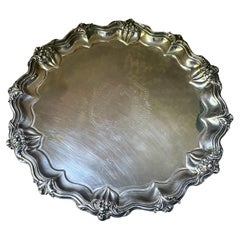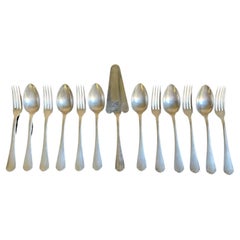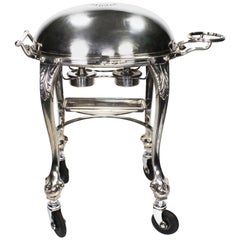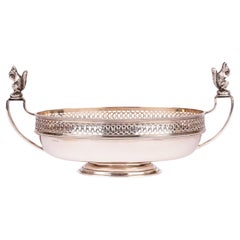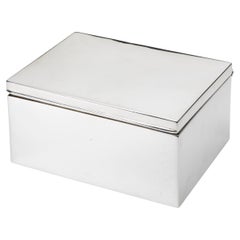Plated Sheffield and Silverplate
1
8
to
2
6
2
8
8
8
4
2
1
32
78
40
31
6
8
6
2
5
5
3
3
1
2
8
7
5
1
1
8
6
5
2
1
1
1
Period: Early 1900s
Technique: Plated
Walker & Hall 1906 Sheffield England Silverplate Salver Footed Tray Plateau
Located in Clifton Forge, VA
Here is an elegant fine quality three footed Walker & Hall Sheffield salver with a lovely art nouveau raised floral and foliate decoration edging the ...
Category
Early 1900s English Art Nouveau Antique Plated Sheffield and Silverplate
Materials
Silver Plate
Antique Christofle Spoons Forks & Cake / Pie Server in Japonais Pattern-13 Piece
By Christofle
Located in Ross, CA
Christofle antique flatware set of six spoons and six forks as well as one vintage pie /cake server included. The spoons and forks were made in Fran...
Category
Early 1900s French French Provincial Antique Plated Sheffield and Silverplate
Materials
Silver Plate
English Silver Plated Art Nouveau Meat Carving Trolley Cart by Elkington
Located in Los Angeles, CA
A very fine English early 20th century century Art Nouveau silver plated "Chariot à Viande" meat-carving trolley-cart on wheels, by Elkington Plat...
Category
Early 1900s English Art Nouveau Antique Plated Sheffield and Silverplate
Materials
Silver Plate
25 Antique Spoon English Silver Demitasse Coffee Tea Spoons 4 Set of 6
Located in Hampshire, GB
4 Set of 6 English Silver Plated Espresso Coffee or Tea Demitasse Spoons
Four beautiful sets of six English sterling silver espresso coffee o...
Category
Early 1900s English Art Nouveau Antique Plated Sheffield and Silverplate
Materials
Sterling Silver, Silver Plate, Metal
Very Fine and Rare Silverplated Caviar Serving Dish
Located in Atlanta, GA
A very fine and rare silverplated caviar serving dish in the neoclassical style. The interior compartment is gold plated. England, circa 1900.
Dim...
Category
Early 1900s English Neoclassical Antique Plated Sheffield and Silverplate
Materials
Bronze
Hallmarked Silver Plated Keepsake Box, Sheffield, Uk, Circa 1900
Located in Colorado Springs, CO
Offered is a stunning Sheffield silver keepsake box dating to 1900, with associated hallmark. This small box includes a clean interior and rounded corners. The box is free of names or initials, but would have been used to house keepsakes such as jewelry or cufflinks. A well maintained, elegant piece, this antique silver box is an excellent addition to any silver collection.
Trinket or keepsake boxes have taken on many forms since their first conception in ancient times. However their purpose remains the same; to store jewelry and other items precious to the owner. Originally, these boxes were used specifically for jewelry. These were in common use as early as 5000 BC in Ancient Egypt, when the majority of Egyptians, both male and female, wore jewelry. Boxes were used to keep these gemstone encrusted items safe. In Ancient Rome, jewelry was a status symbol. Rings and brooches were utilized to represent ones status in society. Again, boxes were needed for security and storage purposes. Finding early examples of these are quite rare.
Victorian and Edwardian examples of trinket boxes are far more common. This is because owning jewellery was a luxury until the Victorian era- let alone possessing so much a box was needed to store it all. Fine jewelry and other items became available to the masses after the industrial revolution due to the reduction in production costs. This led to a demand for trinket boxes, which were much smaller than jewelry boxes and therefore better suited to the needs of the middle class who did not yet possess an abundance of jewelry.
In Victorian households, collectables and other items of interested were also stashed inside these boxes. This is why they are known as trinket or keepsake boxes, rather than just jewelry boxes, although of course jewelry was also stored in them. Trinket boxes were produced in large numbers around this time. Many were lined with colored plush or velvet or rich wood. More elaborate designs had interior divisions and trays for rings and other pieces of jewellery. It was also common to see trinket boxes so small that they could only contain one item, such as a single ring. Ornate exteriors were created to reflect the value of the trinket boxes contents.
The Edwardian era saw the introduction of new styles of trinket box. These included small circular or oblong boxes...
Category
Early 1900s British Art Deco Antique Plated Sheffield and Silverplate
Materials
Silver
Hallmarked Silver Plated Keepsake Box, Sheffield, UK, circa 1900
Located in Colorado Springs, CO
Offered is a stunning silver plated keepsake box dating to 1900, with associated hallmark. This small box includes a wooden interior with two slots and a blank square on top where initials could have been engraved. A well maintained, elegant piece, this antique silver box is an excellent addition to any silver or home decor collection.
Trinket or keepsake boxes have taken on many forms since their first conception in ancient times. However their purpose remains the same; to store jewelry and other items precious to the owner. Originally, these boxes were used specifically for jewelry. These were in common use as early as 5000 BC in Ancient Egypt, when the majority of Egyptians, both male and female, wore jewelry. Boxes were used to keep these gemstone encrusted items safe. In Ancient Rome, jewelry was a status symbol. Rings and brooches were utilized to represent ones status in society. Again, boxes were needed for security and storage purposes. Finding early examples of these are quite rare.
Victorian and Edwardian examples of trinket boxes are far more common. This is because owning jewellery was a luxury until the Victorian era- let alone possessing so much a box was needed to store it all. Fine jewelry and other items became available to the masses after the industrial revolution due to the reduction in production costs. This led to a demand for trinket boxes, which were much smaller than jewelry boxes and therefore better suited to the needs of the middle class who did not yet possess an abundance of jewelry.
In Victorian households, collectables and other items of interested were also stashed inside these boxes. This is why they are known as trinket or keepsake boxes, rather than just jewelry boxes, although of course jewelry was also stored in them. Trinket boxes were produced in large numbers around this time. Many were lined with colored plush or velvet or rich wood. More elaborate designs had interior divisions and trays for rings and other pieces of jewellery. It was also common to see trinket boxes so small that they could only contain one item, such as a single ring. Ornate exteriors were created to reflect the value of the trinket boxes contents.
The Edwardian era saw the introduction of new styles of trinket box. These included small circular or oblong boxes...
Category
Early 1900s English Art Deco Antique Plated Sheffield and Silverplate
Materials
Silver
French Art Nouveau Silverplated Centerpiece "Epergne", Ca. 1900
Located in CH
French Art Nouveau silverplated centerpiece "Epergne", Ca. 1900.
Category
Early 1900s French Art Nouveau Antique Plated Sheffield and Silverplate
Materials
Silver Plate
Related Items
Elkington & Co Victorian Silver Plated Mirror Plateau, Made in 1845
Located in London, London
Carrying old silver plate marks Elkington & Co. in 1845, this attractive, Victorian, Antique Silver Plated Mirror Plateau, features an orna...
Category
1840s English Gothic Antique Plated Sheffield and Silverplate
Materials
Silver Plate
Antique Elkington & Co. Silver Plated Spirit Kettle with Floral Decoration
Located in Hamilton, Ontario
This antique spirit kettle was made by the well known Elkington & Co. of England in approximately 1880 and done in the period Victorian style. Th...
Category
Late 19th Century English Victorian Antique Plated Sheffield and Silverplate
Materials
Silver Plate
Antique Silver Plated Hors d'oeuvres Stand by Christofle 19th C
By Christofle
Located in London, GB
A top quality French Christofle silver plated layered hors d'oeuvres stand. The wrythen finial above five articulated plain polished bowls raised upon a spreading circular foot, bear...
Category
1890s French Antique Plated Sheffield and Silverplate
Materials
Silver
Rectangular Silverplated Tray
Located in Brescia, IT
This modern and timeless tray is perfect to serve coffee or tea. It is very elegant to show a crystal glasses collection or the barware pieces.
Category
21st Century and Contemporary French Modern Plated Sheffield and Silverplate
Materials
Silver Plate
Christofle Silver Plate Wine Trolley
By Christofle
Located in New Orleans, LA
This wonderful late 19th century silver plated wine trolley was crafted by Christofle, the French firm renowned for their commanding silver and plated flatw...
Category
19th Century French Other Antique Plated Sheffield and Silverplate
Materials
Silver, Bronze
Antique Quality Silver Plated Copper Food Dome and Meat Platter
Located in Bridgeport, CT
A classic Oval Serving Dome by Elkington. With gadrooned middle band, incised crown motif and top loop handle. Along with an oval paw footed deep meat platter. Dome dimensions are gi...
Category
Late 19th Century Hollywood Regency Antique Plated Sheffield and Silverplate
Materials
Copper, Silver Plate
Large Antique Engraved Sheffield England Silver Plated Gallery Serving Tray
Located in Hamilton, Ontario
This large serpentine shaped silver plated serving tray was made in Sheffield England in roughly 1910 in the period Edwardian style. This plated tray has a deep gallery with cutout h...
Category
Early 20th Century English Edwardian Plated Sheffield and Silverplate
Materials
Copper
19th Century Georgian, Sheffield Silver Plate Candlesticks, Pair
By Sheffield
Located in Soquel, CA
19th Century Georgian, Sheffield Silver Plate Candlesticks, Pair
Pair of English, Georgian, George IV Sheffield silver plate candlesticks. Vintage, distressed silver finish. Silver ...
Category
1820s English George IV Antique Plated Sheffield and Silverplate
Materials
Sheffield Plate, Copper
1890 Skinner & Co. Art Nouveau Engraved Silver plated English Tea Service
Located in Catania, Sicilia
Unusual Art Nouveau silver plate tea set by Skinner & co., Sheffield, circa 1890, oriental shape, good conditions overall, nice engraving in all four p...
Category
Late 18th Century English Art Nouveau Antique Plated Sheffield and Silverplate
Materials
Silver Plate
Traditional English Eales 1779 Silverplate Oval Footed Engraved Serving Tray
Located in Oklahoma City, OK
A beautiful oval silverplate serving tray by Eales 1779. This piece has lovely scalloped edges and scrollwork to the inside of the piece. It sits upon four scrolled feet which gives ...
Category
20th Century English Regency Plated Sheffield and Silverplate
Materials
Silver Plate
H 1.75 in W 14.5 in D 11.5 in
1950 Christofle France Conchiglia Metallo Argento Set Segnaposti
By Christofle
Located in Brescia, IT
8 Segnaposto "Conchiglia"
Christofle, France
1950
Metallo argentato
Completi di scatola in cartone originale Christofle
Eccellenti condizioni
Category
1950s French Mid-Century Modern Vintage Plated Sheffield and Silverplate
Materials
Metal
Christofle France Silver Plated Plate
By Christofle
Located in Sharon, CT
A heavy 12" signed plate.
Category
1970s American Classical Roman Vintage Plated Sheffield and Silverplate
Materials
Silver Plate
Previously Available Items
Edwardian Fine English Silver-Plated Squirrel Nut Dish
Located in Bishop's Stortford, Hertfordshire
An unusual quality Edwardian English silver plate twin handle nut dish the handles mounted with squirrels by Charles S Green, Birmingham and made around 1905. The dish is of oval shaped standing raised on a narrow oval pedestal base...
Category
Early 1900s English Edwardian Antique Plated Sheffield and Silverplate
Materials
Silver Plate
Silver Plated Keepsake Box, Sheffield, Uk, circa 1900
Located in Colorado Springs, CO
Offered is a stunning silver keepsake box dating to 1900, with associated hallmark. This small box includes a wooden interior and is free of any engraved initials or names. This silver piece features a very simple, practical design. A well maintained, elegant piece, this antique silver box is an excellent addition to any silver collection.
Trinket or keepsake boxes have taken on many forms since their first conception in ancient times. However their purpose remains the same; to store jewelry and other items precious to the owner. Originally, these boxes were used specifically for jewelry. These were in common use as early as 5000 BC in Ancient Egypt, when the majority of Egyptians, both male and female, wore jewelry. Boxes were used to keep these gemstone encrusted items safe. In Ancient Rome, jewelry was a status symbol. Rings and brooches were utilized to represent ones status in society. Again, boxes were needed for security and storage purposes. Finding early examples of these are quite rare.
Victorian and Edwardian examples of trinket boxes are far more common. This is because owning jewellery was a luxury until the Victorian era- let alone possessing so much a box was needed to store it all. Fine jewelry and other items became available to the masses after the industrial revolution due to the reduction in production costs. This led to a demand for trinket boxes, which were much smaller than jewelry boxes and therefore better suited to the needs of the middle class who did not yet possess an abundance of jewelry.
In Victorian households, collectables and other items of interested were also stashed inside these boxes. This is why they are known as trinket or keepsake boxes, rather than just jewelry boxes, although of course jewelry was also stored in them. Trinket boxes were produced in large numbers around this time. Many were lined with colored plush or velvet or rich wood. More elaborate designs had interior divisions and trays for rings and other pieces of jewellery. It was also common to see trinket boxes so small that they could only contain one item, such as a single ring. Ornate exteriors were created to reflect the value of the trinket boxes contents.
The Edwardian era saw the introduction of new styles of trinket box. These included small circular or oblong boxes...
Category
Early 1900s British Art Deco Antique Plated Sheffield and Silverplate
Materials
Silver
Hallmarked Silver Plated Keepsake Box, Sheffield, UK, Circa 1900
Located in Colorado Springs, CO
Offered is a stunning silver plated keepsake box dating to the early 1900s, with associated hallmarks along the side. This small box includes a wooden interior with two slots for storage of jewelry, cufflinks, and other keepsakes. A well maintained, elegant piece, this antique silver box is an excellent addition to any silver collection.
Trinket or keepsake boxes have taken on many forms since their first conception in ancient times. However their purpose remains the same; to store jewelry and other items precious to the owner. Originally, these boxes were used specifically for jewelry. These were in common use as early as 5000 BC in Ancient Egypt, when the majority of Egyptians, both male and female, wore jewelry. Boxes were used to keep these gemstone encrusted items safe. In Ancient Rome, jewelry was a status symbol. Rings and brooches were utilised to represent ones status in society. Again, boxes were needed for security and storage purposes. Finding early examples of these are quite rare.
Victorian and Edwardian examples of trinket boxes are far more common. This is because owning jewellery was a luxury until the Victorian era- let alone possessing so much a box was needed to store it all. Fine jewelry and other items became available to the masses after the industrial revolution due to the reduction in production costs. This led to a demand for trinket boxes, which were much smaller than jewelry boxes and therefore better suited to the needs of the middle class who did not yet possess an abundance of jewelry.
In Victorian households, collectables and other items of interested were also stashed inside these boxes. This is why they are known as trinket or keepsake boxes, rather than just jewelry boxes, although of course jewelry was also stored in them. Trinket boxes were produced in large numbers around this time. Many were lined with colored plush or velvet or rich wood. More elaborate designs had interior divisions and trays for rings and other pieces of jewellery. It was also common to see trinket boxes so small that they could only contain one item, such as a single ring. Ornate exteriors were created to reflect the value of the trinket boxes contents.
The Edwardian era saw the introduction of new styles of trinket box. These included small circular or oblong boxes...
Category
Early 1900s British Art Deco Antique Plated Sheffield and Silverplate
Materials
Silver
Pair of Antique Silver-Plated Serving Dishes
Located in Casteren, Noord-Brabant
Two beautiful silver-plated serving dishes, decorated with graceful ornaments. From England (presumably Sheffield), dating from around 1900. The handles can be removed by turning the...
Category
Early 1900s Antique Plated Sheffield and Silverplate
Materials
Silver Plate
Pair of Edwardian Candlesticks by Parkes and Co of London, circa 1905
Located in London, GB
Extremely large pair of silver plated candlesticks, made by J Parkes and Company.
This firm specialized in bespoke handmade silver and silver plated items...
Category
Early 1900s British George II Antique Plated Sheffield and Silverplate
Materials
Silver Plate
Quality Large Antique English Silver Plated Tea Caddy, circa 1900
Located in Bath, GB
A wonderful quality late Victorian / early Edwardian tea caddy made from silver plate and dating to circa 1900.
The oval caddy has a hinged lid incorporating a central dome. The c...
Category
Early 1900s English Edwardian Antique Plated Sheffield and Silverplate
Materials
Silver Plate
Free Shipping
H 4.25 in W 5.75 in D 4 in
Antique English Cake Stand in Silver Plate, circa 1900
By Maple & Co.
Located in Bath, GB
One of the most lovely cake stands I have had in some time, this three-tier example made from English silver plate. The three circular dishes are quite magnificent, each with a dimpl...
Category
Early 1900s English Edwardian Antique Plated Sheffield and Silverplate
Materials
Silver Plate
Recently Viewed
View AllMore Ways To Browse
Sheffield Silver Ice Bucket
Antique Silver Plated Biscuit Box
Sheffield Ice Bucket
African Royalty
Sheffield Plate Biscuit Boxes
Sheffield Carving
Union Street Glass
Oval Glass Dome
Connecticut Antique Plates
Glass Biscuit Barrel
Victorian Antique Silver Biscuit Box
Meat Dome
Sheffield England 20th Century Silver Plated Hallmarked
Heraldic Silver Plate
Antique Hot Water Urns
English Antique Plate Warmer
Silver Sheffield Serving Dish
Heath Ceramics Plate
